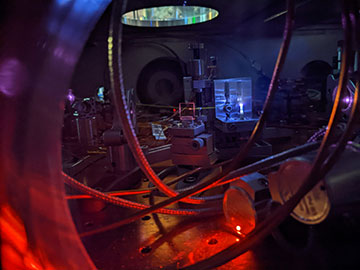
A laser system operating at ultraviolet frequencies has provided a template for the nuclear clocks of the future. [Image: Chuankun Zhang / JILA]
An international research team has realized several key elements of a nuclear clock, a next-generation timepiece that would be more precise than today's atomic devices, while also being less sensitive to outside disturbances (Nature, doi: 10.1038/s41586-024-07839-6). The system exploits ultraviolet light to probe energy transitions in nuclei of thorium-229, which are embedded inside a solid crystal to provide a pathway toward portable and robust timekeeping solutions.
Nuclear transitions
Existing optical clocks work by matching the frequency of laser light to a specific electronic energy transition in ultracold atoms, with the laser frequency determining the shortest interval of time that can be measured. Nuclear transitions occur at higher energies, which should improve the timing precision, while tightly bound nuclei are also less susceptible to external perturbations that can affect the energy levels of an electron, such as stray electromagnetic fields.
However, almost all nuclear transitions occur at frequencies that are far beyond the reach of today’s lasers. One notable exception is the transition of the thorium-229 nucleus to an excited metastable state, which corresponds to ultraviolet light with a photon energy of around 8.4 eV. Earlier this year, two separate groups showed that lasers operating in the vacuum-ultraviolet (VUV) range can be used to excite thorium-299 from its ground state, but they were unable to determine the exact frequency needed to drive the transition.
The team was able to measure the frequency needed to excite the nuclei with an accuracy some 100,000 times higher than has been achieved before.
Optimized optical frequency comb
Now, a team led by Jun Ye at the JILA research institute in Boulder, CO, USA, has achieved that milestone by building and optimizing an optical frequency comb that operates at VUV wavelengths. This specialized laser system allows trillions of thorium-229 nuclei to be probed with many precise frequencies at the same time, with any nuclei excited by the comb emitting light at the transition frequency as they decay back to their ground state.
The frequencies produced by the comb are also synchronized with one of the world's most accurate optical clocks, a device at JILA that measures the electronic oscillations in strontium atoms. By establishing a direct link between the nuclear transition and this reference timepiece, the team was able to measure the frequency needed to excite the nuclei with an accuracy some 100,000 times higher than has been achieved before.
While the system does not yet function as a clock that can measure time, the precise determination of the transition frequency will inform the design of a high-power VUV laser that would enable coherent control of the nuclear-energy states. In the meantime, measuring the transitions in thorium-229 nuclei could offer new insights into the forces that hold protons and neutrons together, and how they might be affected by external factors such as the presence of dark matter.
